[Versió catalana] [Versión castellana]
Virginia Ortiz-Repiso
Lecturer at the Faculty of Library and Information Science
University of Carlos III de Madrid
Abstract
Objectives: The main objectives of this paper are to provide an overview of the current state of studies in library and information science in Spanish universities and to discuss the challenges this discipline is facing and the strategies that might strengthen the position of LIS-related studies and professional practice. But the paper also reconsiders why LIS in Spain is crossing the boundaries in two ways. First, it examines interdisciplinarity in LIS and identifies some of the travel companions LIS has made on its journey across the boundaries; and second, it analyzes the negative social repercussions LIS has experienced. Finally, the paper proposes initiatives to mitigate the low visibility of LIS education and the profession as a whole.
Methodology: Data were gathered from the official agencies the Spanish Ministry of Education, Culture and Sports, the Instituto Nacional de Estadística (National Institute of Statistics, INE) and the Red de Centros y Departamentos de Información y Documentación (Network of University Centres and Departments of Information and Documentation, RUID). Further data were obtained from the annual reports of Spanish universities.
Results: We describe the current situation of undergraduate courses, master's degrees and doctoral programmes. Among other observations, we note the general decrease in the demand for LIS undergraduate studies and we propose that the increase in postgraduate studies is unsatisfactory. Finally we reflect on the challenges that these studies are currently facing in this country and suggest strategies that may be used to strengthen the position of both LIS education and the profession as a whole.
Resum
Objectius: l'objectiu principal d'aquest article és oferir una visió general sobre la situació actual dels estudis de Biblioteconomia i Documentació (BID) a les universitats espanyoles i examinar els reptes als quals s'enfronta avui dia aquesta disciplina, com també les estratègies que cal seguir per potenciar-la. Ara bé, vol anar una mica més enllà en reconsiderar per què els dels estudis de Biblioteconomia i Documentació a Espanya traspassen els límits en dos sentits. D'una banda, la interdisciplinarietat, és a dir, la identificació dels nostres companys de viatge; de l'altra, l'anàlisi de l'escassa repercussió social. Es proposen algunes iniciatives per tal de mitigar la baixa visibilitat d'aquests estudis i de la professió en conjunt.
Metodologia: les dades s'han extret de fonts estadístiques oficials (Ministerio de Educación, Cultura y Deportes i Instituto Nacional de Estadística) i de les memòries anuals de les universitats, i s'han complementat amb la informació proporcionada pels membres de la Red de Centros y Departamentos Universitarios de Información y Documentación (RUID).
Resultats: es descriu la situació actual dels cursos de grau i dels programes de màster i doctorat. Entre altres qüestions, s'ha detectat una disminució general de la demanda d'estudis de grau de Biblioteconomia i Documentació i un augment poc satisfactori dels programes de postgrau. En darrer lloc, es presenten diverses reflexions sobre els reptes als quals s'enfronten actualment aquests estudis i es proposen les estratègies que es poden aplicar per reforçar no solament l'ensenyament en aquest camp, sinó també el conjunt de la professió en aquest país.
Resumen
Objetivos: el objetivo principal de este artículo es ofrecer una visión general sobre la situación actual de los estudios de Biblioteconomía y Documentación (ByD) en las universidades españolas y examinar los retos a los que se enfrenta hoy en día esta disciplina, así como las estrategias que deben seguirse para potenciarla. Ahora bien, quiere ir un poco más allá al reconsiderar por qué los de los estudios de Biblioteconomía y Documentación en España traspasan los límites en dos sentidos. Por un lado, la interdisciplinariedad, es decir, la identificación de nuestros compañeros de viaje; por otro, el análisis de la escasa repercusión social. Se proponen algunas iniciativas con el fin de mitigar la baja visibilidad de estos estudios y de la profesión en su conjunto.
Metodología: los datos se han extraído de fuentes estadísticas oficiales (Ministerio de Educación, Cultura y Deportes e Instituto Nacional de Estadística) y de las memorias anuales de las universidades, y se han complementado con la información proporcionada por los miembros de la Red de Centros y Departamentos Universitarios de Información y Documentación (RUID).
Resultados: se describe la situación actual de los cursos de grado y de los programas de máster y doctorado. Entre otras cuestiones, se ha detectado una disminución general de la demanda de estudios de grado de Biblioteconomía y Documentación y un aumento poco satisfactorio de los programas de posgrado. En último lugar, se presentan varias reflexiones sobre los retos a los que se enfrentan actualmente estos estudios y se proponen las estrategias que pueden aplicarse para reforzar no solo la enseñanza en este campo, sino también el conjunto de la profesión en este país.
1 Introduction
The studies, research and the very profession of Library and Information Science (LIS) have been in constant evolution. The present time is no exception. The word "change" is part of us. The main reason for this can be found in its close ties to technology on a double level. On the one hand because it uses it to monitor, organize and offer services. On the other, because it is the same technology which multiplies and diversifies information, its duties and its actors.
In fact, current Information Science is the crossroads of Information, Technology and People.
The main objective of this contribution is to provide an overview of the current state of Library and Information Science (LIS) in Spanish universities. But it aims to go a little bit further by reconsidering why LIS in Spain is crossing the boundaries.
I'm going to use data that show the state of art as far as education, research, employment, the job offer types and, finally, the employment sectors and the profiles they want, is concerned. I will specially mention the interdisciplinarity and the identification of our travel companions.
Finally I will present several reflections on the challenges that these studies are currently facing, and suggest strategies that may be followed to strengthen, not only LIS education, but also the profession as a whole in this country.
Source data have been gathered from official statistical sources (Spanish Ministry of Education, Culture and Sports and National Institute of Statistics) and annual reports from the universities as well as data provided by members of the Spanish Network of Information and Documentation University Centers and Departments (RUID).
2 Spanish LIS education
I think it would be useful, first, to look at the origin of Library and Information Science (LIS) studies in Spain. The development of LIS has been radically different from the U.S. and UK which have a long experience, but similar to other European countries where the university studies started in the 70s and 80s.
However, Spain does have a certain tradition:
- Barcelona School was founded in 1915 (it was the second in Europe next after Leipzig, 1914). But it was not linked to the university. It was basically a professional activity.
- The School of Technical training for Archivists, Librarians and Archeologists which was founded by the Spanish National Library in 1953.
These studies were basically directed at women and university undergraduates of Humanities studies.
In Spain, the LIS university studies appeared in 1982 with the first undergraduate programs in the university context (Diplomatura). Nowadays, LIS education includes Bologna undergraduate as well as Master and PhD levels and they are offered by 15 centers (figure 1).
In the beginning LIS was associated only with humanistic faculties but now it is increasingly frequent to find it affiliated with social sciences, especially with Communication Studies. However, at the department level, the situation is different because nearly 50% do not share it with other areas, as we can see in figure 1.
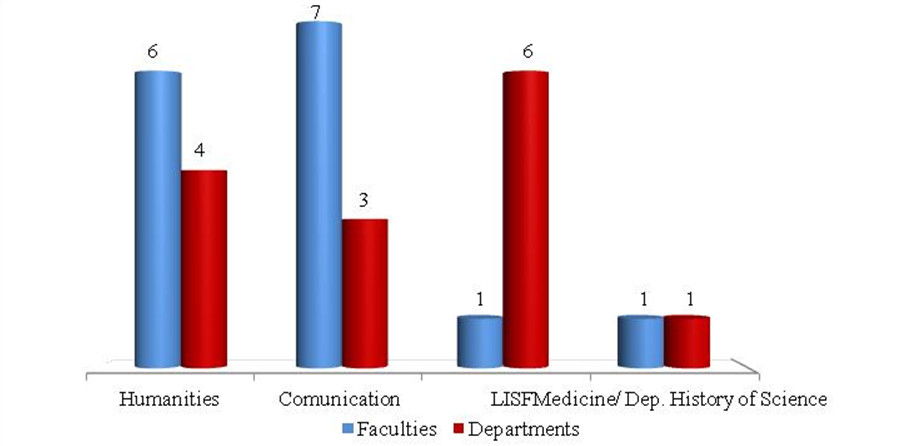
Figure 1. Spain. Information science is affiliated with other disciplines (Faculties/Departments)
In certain cases the affiliation has more to do with the structure or the politics of the universities themselves than with the discipline in question.
2.1 Background
The LIS training fulfills the need for professionally educated librarians in the Civil service, specifically at the public libraries (Abadal, 1993). In fact, the expansion of the public libraries that took place in the 80s and especially in the 90s (Hernández, 2001) brought about a proportional demand for such studies. The historical high point was in 1999/2000 as can be seen in figure 2: 4.859 students.
In the beginning of the 90s, the increasing demand for undergraduate studies justified the extension of the training with a second cycle (bachelor) initially with very satisfactory results, although the number of students began to decrease in 2002 (figure 2).
A more detailed study can be found it in Moneda (2014a).
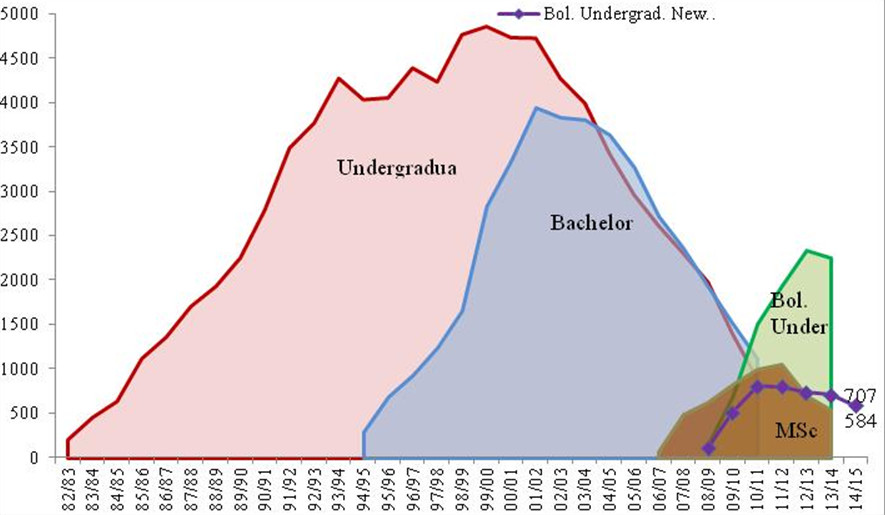
Figure 2. The evolution of University studies in Spain (1982-2014)
2.2 Bologne: European Higher Education Area (EHEA)
EHEA became a fact from 2007 and the earlier studies were being extinguished or transformed (in 2015 they had ceased to exist in all universities). Bologne undergraduate studies (Grado en Información y Documentación / Bachelor's Degree in Information and Documentation) that are taught in 12 centers, responded both to the decrease in student demand and the new labour market conditions: a drop in the number of public job offers and a corresponding rise in the private sector (Montes López, 1995; ANECA, 2004; Tejada Artigas; Moreiro, 2003; Abadal; Borrego; Serra-Pérez, 2012).
The new study plans aimed at creating an education which would allow a wider professional spread as well as a specialization more in line with reality (Morales Sanabria, 2012). According García Marco (2009), Bologne Undergraduate studies proved to be an important improvement following the ideas of iSchools initiative.
The number of newly enrolled undergraduate students was an increase compared to that of the former studies, but did not reach the numbers of the 90s as can be seen in figure 2. Between 2011 and 2015 a 28% drop in the demand for undergraduate studies can be observed. There are different reasons for this: positioning, the number of available grants and the remarkable rise in prices in many regions. It doesn't cost the same to study in Valencia, Madrid or Cataluña (which have suffered a rise of 33, 3%, 38, 1 % and 66,7% respectively) as it does in other places in Spain where the rise oscillates between 0% in Galicia and 11,8% in Murcia (Ortiz-Repiso, 2013).
The cost for enrollment in Bologna Undergraduate in state universities (according to the prices of 2014/2015) oscillates between 2.364 and 6.064,80 Euros. As far as a private university is concerned, the prices can reach 12.000 Euros (MECD, 2013a).
It would be easy and tempting – although not very serious – to establish a cause-effect relationship: prices/enrollments. A much more inclusive analysis is needed. There is, however, no doubt that the higher prices and the economical situation in Spain, our weak positioning …. Have a negative effect on the choice of studies.
2.3 Masters
The offer for masters in the LIS area is very wide-spanning. There are 53 titles, out of which 27 (49,1%) are official masters and 28 (50,9%) are titles offered by each university. All of them are in the area of LIS in the widest possible sense.
As far as the topics of the studies is concerned (figure 3) the generalist programs are the most common (Information Science and Archivism) followed by management titles (Information Management, Content Management, Knowledge Management, Social Media, etc.) and Museology. Those which are related to School libraries, Medical documentation or Musical Documentation represent the lowest percentage.
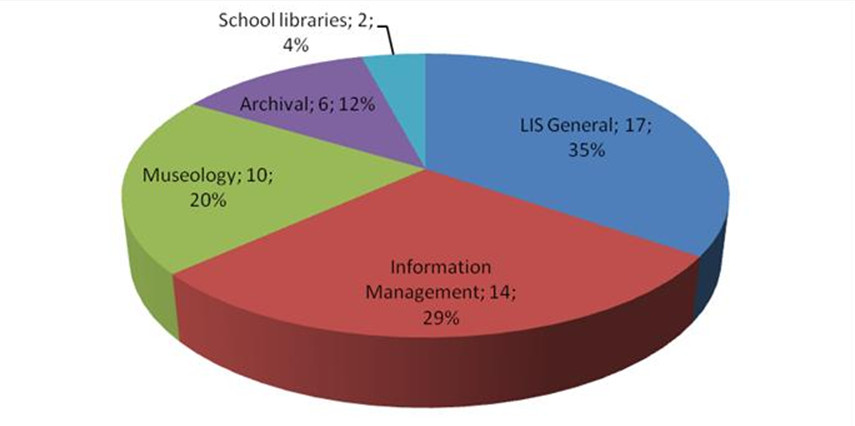
Figure 3. Masters by subject
Not all of them depend on the LIS departments or Faculties (figure 4).
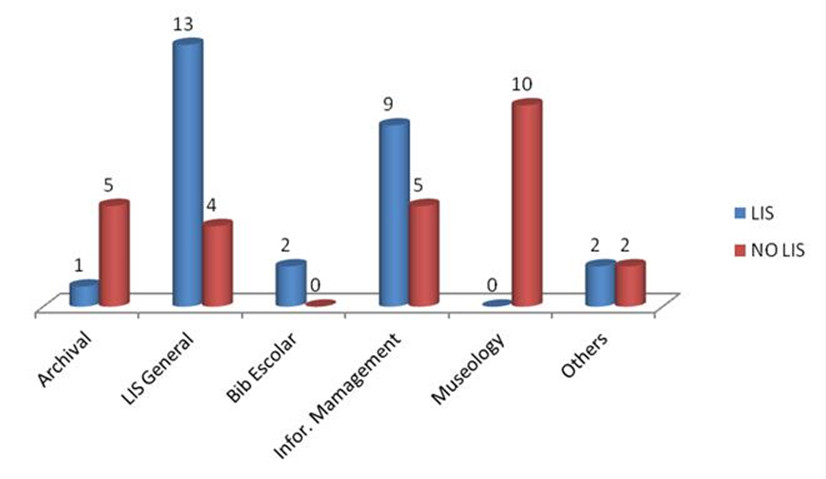
Figure 4. LIS Masters Studies in Spain
2.4 New laws ... more changes
Spain seems to be always immersed in new educational laws. As far as I am concerned, I would like to live in a country with a stable educational politics such as UK, France, Germany or Scandinavia, but history is like genetics: its traces are indelible. Bologne undergraduates have not yet been accredited and nonetheless the Government has passed a new law with different rules for the educational game. Less than seven years have gone by since the last reform and we are already experiencing a new change… again. The new Real Decreto 43/2015 offers the possibility to fit undergraduate studies into three year models as in many European countries. Apart from the convenience of a shorter study, it will also result in the coexistence of different curricula models: three years for undergraduates + 2 years for masters, four years for undergraduates +1 year for masters and countless other combinations. This might spread confusion in families, companies and the universities themselves (Moreiro, 2015).
3 PhD Dissertations and research
The PhD programs are the main academic justification. In USA, these became common after the Second World War (Powell, 1995), but, in Spain, it did not happen until the 90s. This was when the research in the field really took off. The PhD programs started in 1991. The first PhD dissertation was defended in 1995.
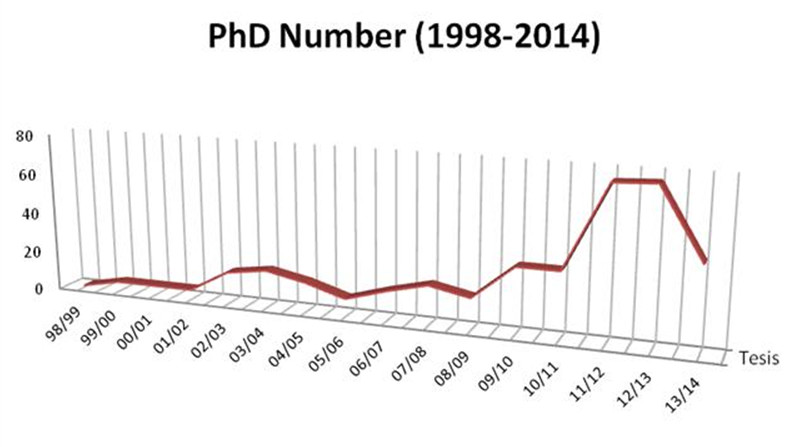
Figure 5. PhD dissertations 1998-2014 (385 PhDs)
This development (figure 5) has caused the emergence of a new breed of teachers and researchers with a different approach and different work methods compared to the traditional practitioners. In fact, as I already mentioned, in 1995 the first PhD dissertation was defended, and only in year 2000 did the first person to have done the entire LIS cycle receive his PhD. Before then, LIS PhDs were done in other departments.
LIS changed from a professional field focused on librarianship to an academic field focused on information and use. And in 1992, LIS began receiving a growing number of citations from outside the field, notably from Computer Science and Management.
There is a natural relationship between research and science. The more research, the more articles. The more articles published in international journals, the better foundation for the field. And, finally, a more solidly founded field generates even more articles.
We can see that evolution in figure 6. These data are reflected in the scientific production on an international level. Between 2006-2008 two Spanish journals were indexed by WOS which caused an increase in the number of papers. If they were excluded, the tendency would be the same.
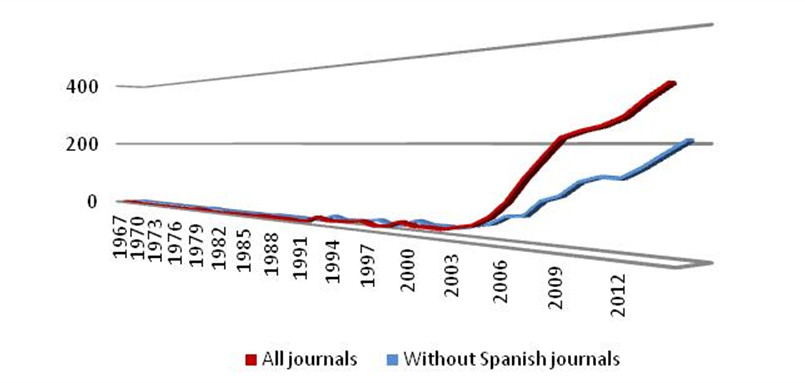
Figure 6. Spanish works at an international level (2205 articles1967-2014 (source: WOS)
In the beginning LIS in Spain was associated with humanistic faculties only, but now it is increasingly frequent to find it linked with the fields of Computer Science or Social Sciences. The research trends have also changed: While the topics used to be linked either with practical matters concerning library operations or be purely theoretical, today bibliometrics and scientometrics are clearly positioned, and so are the topics related to information architecture, semantic web, linked data and digital environments and the work teams are increasingly interdisciplinary.
The trend in publication patterns has also changed: if papers were previously published primarily in Spanish and in Spanish magazines, they are now more often published in international journals and in English.
As we can see from the number of articles collected in the Web of Science (WOS), Spain is in a good position both internationally (third) and on a European (second) scale (figures 7 and 8). It ranks third in the world and second in Europe.
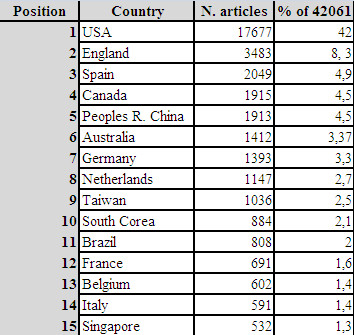
Figure 7. Number of articles in LIS journals (WOS) (2000-2014) by countries (n=42061)

Figure 8. Number of articles in LIS jounals (WOS) (2000-2014) by European countries (n=12567)
Ardanuy and Urbano (2015) show similar results in their study using as a source Scopus: this ranking is similar to the results of WOS (figure 9).
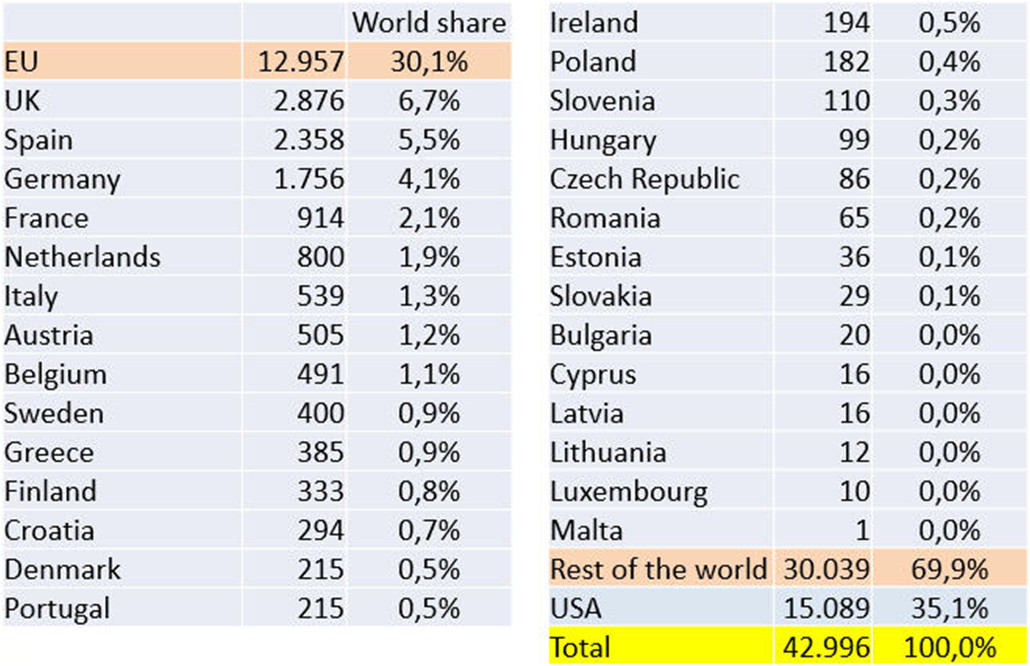
Figure 9. Authorship: share by EU countries VS USA and rest of world (2010-2014). Source: Ardanuy and Urbano (2015) http://bd.ub.edu/liser/sites/bd.ub.edu.liser/files/Programa/ppt/slides_ArdanuyUrbano_LIS-ER_5June2015.pdf
4 How is interdisciplinary perceived in Spain?
Interdisciplinarity borrows from other disciplines and integrate this information to produce new understandings and meanings. This activity, which goes against the grain of what many traditional researchers have been taught to do, is needed because knowledge is increasingly interdisciplinary and boundary crossing is commonplace.
Boix Mansilla, Miller, and Gardner (2000) are interested in the kind of knowledge that interdisciplinary studies produce. Individuals demonstrate disciplinary understanding, they say, "when they use knowledge and modes of thinking in disciplines such as history, science, or the arts, to create products, solve problems, and offer explanations that echo the work of disciplinary experts". By contrast, individuals demonstrate interdisciplinary understanding "when they integrate knowledge and modes of thinking from two or more disciplines in order to create products, solve problems, and offer explanations, in ways that would not have been possible through single disciplinary means".
Multiple studies have noted the important role of disciplinary backgrounds in the interdisciplinarity of LIS. As Saracevic (1999) said: "interdisciplinarity in information science was introduced and is being perpetuated to the present by the very differences in backgrounds of people addressing the described problems".
One could argue that the simultaneous presence of people from various backgrounds merely represents proximity of disciplines (hence, multidisciplinarity) and does not in itself constitute interdisciplinarity. However, if one considers the output of the dissertation as the integration of these multiple contexts, then one might argue that the composition of the committees is an indicator of interdisciplinarity. As noted by Holland, in educational initiatives, "the responsibility is left with the student to integrate the disciplinary approaches presented to them"
LIS is naturally interdisciplinary but sometimes it is hard to see. I'm going to briefly analyze the degree of interdisciplinarity from two points of view: study plans and scientific publications.
Moneda (2014b) has published a remarkable work on the subject. She shows us that the interdisciplinarity in undergraduate studies amounts to 34%. She maintains that the interdisciplinarity varies according to the subjects included in the schedule. It amounts to 70 % in the basic education. The interdisciplinary decreases as the schedule becomes more specialized. In the non-obligatory education, the percentage is 32%. Finally, in the core education, the percentage is only 15 %. Information Technologies are the core subject as far as interdisciplinarity is concerned.
Speaking about publications, some authors state that these contain a huge degree of interdisciplinary. This is due to the high number of articles which are published in journals that do not belong to the LIS areas. They come from Medicine and
Chemistry. However, this does not mean that the teams are interdisciplinary as the authors are LIS scientists. Furthermore, LIS frequently cites from other areas, but they do not cite us.
5 Job market
It is not surprising that the number of unemployed in our sector has increased since 2009, taken into account the economical crisis in Spain (figure 9). The sector that has been hit the hardest is the age group between 25 and 35 years. The present jobless rate in the country is 26% (InfoJobs, 2014).
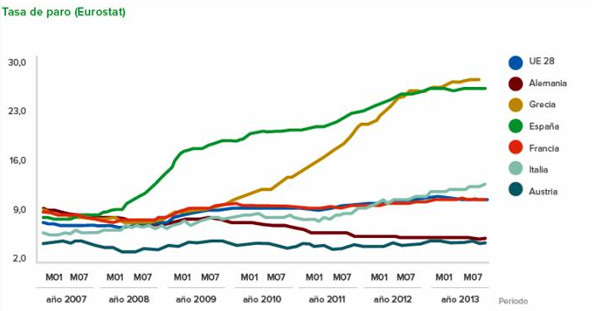
Figure 10. Unemployment rate (Eurostat). Source: MECD (2014a)
According to the Observatory of Occupations of Public State Employment Service (SEPE, 2014a; 2014b) there were in 2014, 2.704 unemployed in the area and 3.982 had obtained employment. The balance may seem positive, but out of those jobs only 62.9% were within sectors related to the profession (archives, libraries and museums) and, mostly, in precarious conditions. The rest had obtained a contract, also precarious, in such diverse occupations as vendors, waiters, janitors or administrative staff.
Numerous studies have been undertaken from different perspectives, analyzing the state of the art and most have reached similar results. I shall here mention the most recent. Abadal (2012; 2014) has analyzed the job offers at the Faculty of Library and Information Science at the University of Barcelona between 2009-2010 and 2011-2012. Martin Gonzalez (2014) has studied those of the University of Salamanca. Merlo Vega (2011) and Hernandez Sánchez (2014) conducted a survey of information professionals in Spain. The works by Marquina (2013), Cobarsí (2014), Moneda (2014a), Moreiro (2014), Tejada (2014) ought also to be mentioned in this context.
Tejada, Chacon and Moreiro (2014) analyzed the job offers at Iwetel from 2008-2013 (641 offers). His analysis shows a steady decline as seen in figure 10.
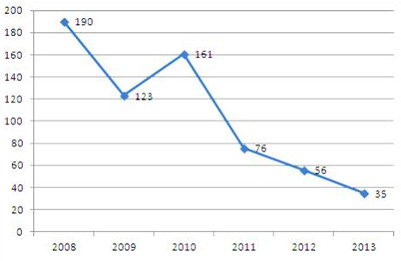
Figure 11. Evolution of the number of job postings per year: 2008-2013 Iwetel (641 offers). Source: Tejada et al. (2014)
The job offers are mainly from Madrid (42.4%), Barcelona (11.6%) and the Basque Country (10.3%). These three communities collected 64.3% of all offers. Of those jobs, only 9% are permanent contracts, the rest are for less than one year (61%) or somewhat longer (32%). Unfortunately the job offers are only limited and temporary. Furthermore, the needs, requirements or working conditions are too often not specified.
5.1 Profile types and Center Characteristics
Employment is primarily found within the traditional sectors, but a new sector within the digital field is also rapidly emerging: portals, digital libraries, management, etc. The decline of government job offers can be seen in all the studies.
- The professional profile which is demanded is undergoing a change. The basic characteristics are:
- The offers are not directed only to LIS graduates.
- Internet and social networks: one of the fields where recruitment continues, sometimes in competition with other degrees. The job offers are becoming ever more specific and high specialization is requested.
For this reason, many training courses are offered by associations, universities and training centers:
- Mobile devices
- Social networks
- Content Curator
- Search Engine Optimization (SEO)
- Marketing online
- Social Media y Community Management
- Cloud Computing
- Content Marketing
- Marketplaces of Freelance Services
- Information Architects
- …
5.2 Mining New Jobs
As we can see in the Study of Professional Profiles most in demand in the field of Digital Contents in Spain 2012- 2017 (Consejo de Cooperación Bibliotecaria, 2013): The reality of library services need many hybrid profiles with roles and responsibilities that often go beyond the field covered by LIS. Perhaps the reason is not so much that they go beyond our discipline, but rather that they are evolving in step with technology and social practices that derive from it.
The Estudio de Perfiles Profesionales más demandados en el ámbito de los Contenidos Digitales en España 2012- 2017 undertaken by the Fundación de Tecnologías de la Información (2012), focusses on these four professions:
- Digital Marketing
- Community Manager
- Programmer
- Designer.
It should be noted that in this report, only three profiles are explicitly related to the Degree in Information and Documentation: Content Curator, eHealth Consultant and Content architect.
According to the European Community, it is expected that by 2017 there will be 700,000 digital profile vacancies in Europe (FTI, 2012). Many of the technical or business related profiles within the digital content industry are transversal and may be a great opportunity for LIS specialists. It will therefore be necessary to build or adapt existing training programs in order to respond to this demand (figure 11), without forgetting to place it in the context of the e.Skills campaign for Jobs and the Manifesto (European Commission, 2014).

Figure 12. Professional profiles most demanded in the field of Digital Contents in Spain 2012 - 2017. Fundación de Tecnologías de la Información (FTI, 2012)
6 Conclusions and Debate
In Spain not everything is wine and roses. According to data provided by the Ministerio de Educación Cultura y Deporte (Ministry of Education, Culture and Sports) it seems that we are again on a downhill slide in the number of university students like the one we experienced before the economical crisis. Thus, one could say that the growth in number of college students has occurred between the courses 2008-2012. A period which was exceptional due to the crisis, the adaption to the EHEA and the new official masters, which increased the number of students until a stabilization set in in 2012-2013.
In LIS, the number of students is decreasing more than in other areas. The main reasons for this are to be found in the current economic crisis, government policies and an endemic lack of social recognition of our profession.
Excellent results in international publications are achieved and yet the number of students decreases... employment is unstable and precarious: it seems that there is a contradiction. We have formed good researchers and professionals, but we do not succeed in increasing the visibility of what we do.
The cost of studies at state universities varies from region to region with some very significant differences. Spanish citizens have to pay different rates simply because of the geography.
One of the main objectives of the implementation of undergraduate studies was to adapt to the labor market and to a new reality for our profession. From the data analyzed, we may conclude that this objective has not been fully achieved. Although a certain increase was on its way, now new enrolment is generally speaking on a downward path and the ratio of students who leave the studies before they graduate is higher than we would like.
The low social visibility of the studies and the profession, which now has become endemic, is one of the most important weaknesses. It is somewhat paradoxical that our studies are not more in demand in a society dominated by information and new job profiles.
Here are some measures (some of them to be found in Ortiz-Repiso; Calzada; Aportela, 2013) that may contribute to improving the situation:
- Reviewing and updating of curricula. Many national and international experts emphasize the necessity of this (Bustelo, 2014; Cobarsí, 2014; Connaway, 2014; García Marco, 2014; Moreiro, 2014; Taladriz, 2014; Ortiz-Repiso, 2013; Marchionini, 2012; Partridge, 2011).
- Reviewing of offers for specialized masters.
- Establishment of strategic alliances with other areas: curricular and international collaborations, etc.
- Professional marketing in companies: actions aimed at increasing the sensitivity of companies to our profession.
- Actions to develop the image of the profession in society as a whole: increased visibility in the media, participation in events, articles, interviews, etc.
- Actions to increase visibility on the Internet, particularly on social networks.
- Development of joint promotional actions between universities / professional associations: information portal, videos, etc.
The current situation should worry (and occupy) not only the academic environment, but the profession as a whole. It is obvious that without graduates, there will be no professionals. This means that the posts, even more often than is the case today, in the future will be occupied by people with inadequate profiles.
7 References
Abadal, E. (1993). "La formación en Biblioteconomía y Documentación en España". Documentación de las Ciencias de la Información, n.º 16, p. 9-46. <http://revistas.ucm.es/index.php/DCIN/article/view/DCIN9393110009A/20105. [Consult: 02/03/2015].
– (2014). "La biblioteconomía y la documentación en la universidad española a principios del siglo XXI". Nuovi annali della scuola speciale per archiviste e bibliotecari, vol. 27, p. 211-228.
Abadal, E.; Borrego, ángel; Serra-Pérez, Rafael (2012). "Mercado laboral de profesionales de la información: evolución de la oferta y de los perfiles ocupacionales". BiD: textos universitaris de biblioteconomia i documentació, n.º 29 (diciembre). <https://bid.ub.edu/29/abadal2.htm>. [Consult: 02/03/2015].
Agencia Nacional de Evaluación de la Calidad y Acreditación [España] (2004). Libro blanco: Título de grado en información y documentación. Madrid: Aneca. <http://www.aneca.es/var/media/150424/libroblanco_jun05_documentacion.pdf>
Ardanuy, J.; Urbano, C. (2015). "Some research questions to frame a European Union overview on LIS research". En: III International Seminar on LIS. Education and Research (LIS-ER). <http://bd.ub.edu/liser/content/programme#sthash.hBXUEc32.dpuf>
Boix Mansilla, V.; Miller, W. C.; Gardner, H. (2000). "On disciplinary lenses and interdisciplinary work". En: Interdisciplinary curriculum - challenges to implementation, p. 17-38. New York: Teachers College Press.
Bustelo Ruesta, C. (2014). "Actitudes de un buen profesional: dejemos de hablar de intrusismo". BiD: textos universitaris de biblioteconomia i documentació, n.º 32 (junio). </es/32/bustelo2.htm>. [Consult: 02/03/2015].
Cobarsí-Morales, J. (2014). "Information Schools. Perspectiva y tendencias en 2013". Anuario ThinkEPI, vol. 8, p. 52-55.
Connaway, L. S. (2014). "Why Libraries? A Call for Use-Centered Assessment". BiD: textos universitaris de biblioteconomia i documentació, n.º 32 (juny). </en/32/connaway3.htm>. [Consult: 04/03/2015].
Consejo de Cooperación Bibliotecaria. Grupo de Trabajo sobre Perfiles Profesionales (2013). Perfiles profesionales del sistema bibliotecario español: fichas de caracterización. Coordinadores: Carlos Miguel Tejada Artigas y Belén Martínez González. <http://travesia.mcu.es/portalnb/jspui/handle/10421/6841>. [Consult: 05/03/2015].
European Commission (2014). Manifiesto de las competencias digitales. European Schoolnet & DIGITALEUROPE (e-Skills for Jobs). <http://ametic.es/sites/default/files//manifiesto_competencias_digitales2014.pdf>. [Consult: 07/03/2015].
Fundación de Tecnologías de la Información (FTI) (2012). Perfiles profesionales más demandados en el ámbito de los contenidos digitales en España 2012-2017. <http://ametic.es/sites/default/files/pafet_vii_perfiles_profesionales_cd_fti-rooter_1.pdf>. [Consult: 10/03/2015].
García Marco, F. J. (2009). "El movimiento iSchools: posicionando los estudios de biblioteconomía y documentación en la era de la información". Anuario ThinkEPI, vol. 3, p. 95-99. <https://www.researchgate.net/publication/44204715_El_movimiento_iSchools_posicionando_los_estudios_
de_biblioteconoma_y_documentacin_en_la_era_de_la_informacin>. [Consult: 10/03/2015].
García Marco, F. J. (2013). "Educación y aprendizaje de la información y la documentación: raíces, desafíos y líneas de actuación". El profesional de la información, vol. 22, n.º 6, p. 489–504. <http://www.elprofesionaldelainformacion.com/contenidos/2013/noviembre/01.pdf>. [Consult: 02/04/2015].
Hernández Sánchez, H. (2001). "Qué bibliotecas públicas hay en el Estado español". En: Las bibliotecas públicas en España: una realidad abierta. Madrid: Fundación Germán Sánchez Ruipérez. <http://www.bibliotecaspublicas.info/bp/bp01_2-1.htm>. [Consult: 02/03/2015].
Hernández Sánchez, H.; Gómez Hernández, J. A.; Merlo Vega, J. A. (2014). "Los profesionales de la información en España, tres años después". En: Anuario ThinkEPI, vol. 8, p. 39-44.
Holland, G.A. (2008). "Information science: an interdisciplinary effort? " Journal of Documentation, vol. 64, no. 1, p. 7-23. <http://dx.doi.org/10.1108/00220410810844132>. [Consult: 06/04/2015].
InfoJobs (2014). Estado del mercado laboral en España 2013. Barcelona; Madrid: ESADE, Universitat Ramon Llull. <http://nosotros.infojobs.net/prensa/informes/informe-el-estado-del-mercado-laboral-espanol-2013>. [Consult: 15/03/2015].
Instituto Nacional de Estadística (España) (2012). Estadística de Enseñanza Universitaria: cursos 1998-1999 al 2010-2011. <http://www.ine.es/jaxi/menu.do?type=pcaxis&path=%2Ft13%2Fp405&file=inebase&L=0>. [Consult: 08/03/2015].
Instituto Nacional de Estadística (España) (2013). Anuario estadístico de España: años 1983 al 1998. <http://www.ine.es/prodyser/pubweb/anuarios_mnu.htm>.[Consult: 08/03/2015].
Marchionini, G.; Moran, B. (eds.) (2012). Information Professionals 2050: Educational Possibilities and Pathways. North Carolina: School of Information and Library Science of University of North Carolina at Chapel Hill. <http://sils.unc.edu/sites/default/files/news/Information-Professionals-2050.pdf>. [Consult: 02/03/2015].
Marquina, J. (2013). Informe Apei sobre bibliotecas ante el siglo XXI: nuevos medios y caminos, 2013. <http://www.apei.es>. [Consult: 02/03/2015].
Martín González, Y.; Travieso Rodríguez, C.; Ríos Hilario, A. B.; Hernández Olivera, L.; Caro Castro, C. (2014). "La inserción profesional de los graduados en Información y Documentación: el caso de la Universidad de Salamanca". BiD: textos universitaris de biblioteconomia i documentació, n.º 32 (junio). <https://bid.ub.edu/wp-content/pdf/32/es/martin2.pdf>. [Consult: 02/04/2015].
MECD: España. Ministerio de Educación, Cultura y Deporte (2013a). Estadísticas de precios públicos universitarios: Curso 2012-2013. <http://www.mecd.gob.es/servicios-al-ciudadano-mecd/estadisticas/educacion/universitaria/precios.html>. [Consult: 02/04/2015].
− (2013b). Tesis doctorales: TESEO. <https://www.educacion.gob.es/teseo/irGestionarConsulta.do>. [Consult: 02/03/2015].
− (2014a). Datos básicos del sistema universitario español. Curso 2013/2014. <http://www.mecd.gob.es/dms/mecd/educacion-mecd/areas-educacion/universidades/estadisticas-informes/datos-cifras/DATOS_CIFRAS_13_14.pdf>. [Consult: 02/04/2015].
− (2014b).Estadísticas de educación. Enseñanzas universitarias. Estadística de estudiantes universitarios. Estudiantes egresados. <http://www.mecd.gob.es/educacion-mecd/areas-educacion/universidades/estadisticas-informes/estadisticas/alumnado/2013-2014_Rend.html>. [Consult: 08/03/2015].
− (2014c). Inserción laboral de los estudiantes universitarios. <http://ep00.epimg.net/descargables/2014/10/28/4c0e7e16ccb94b0ec9bd08a9c62f6299.pdf>. [Consult: 05/04/2015].
Merlo Vega, J. A.; Gómez Hernández, J. A.; Hernández Sánchez, H. (2011). Estudio FESABID sobre los profesionales de la información: prospectiva de una profesión en constante evolución. Madrid: FESABID. <http://eprints.rclis.org/18057>. [Consult: 02/04/2015].
Moneda, M. de la (2014a). "La interdisciplinaridad en los grados de Información y Documentación". BiD: textos universitaris de biblioteconomia i documentació, n.º 32 (junio). </es/32/moneda2.htm>. [Consult: 02/03/2015].
– (2014b). "Las cifras de la enseñanza universitaria en documentación en España: 2012". Anuario Thinkepi, vol. 8, p. 24-38. <http://recyt.fecyt.es/index.php/ThinkEPI/article/view/29548>. [Consult: 02/03/2015].
Montes López, E. (1995). "El mercado de trabajo de los documentalistas en España: análisis de una muestra de ofertas de empleo, 1984-1994". Revista Española de Documentación Científica, vol. 18, n.º 2, pág. 178–187. <http://dx.doi.org/10.3989/redc.1995.v18.i2.655>. [Consult: 08/04/2015].
Morales Sanabria, C. (2012). "Mapa de los estudios de Información y Documentación en España". Clip: Boletín de SEDIC, n.º 66. <http://www.sedic.es/p_boletinclip66_panorama_imprimir.htm>. [Consult: 02/03/2015].
Moreiro, J.A. (2014)."Aún en torno a la formación universitaria, el empleo y la recesión". Anuario Thinkepi, vol. 8.
− (2015). "Al hilo de las noticias sobre planes de estudio y mercado de trabajo". Iwetel (THINKEPI), 7 de febrero de 2015. <https://listserv.rediris.es/cgi-bin/wa?A2=ind1502A&L=IWETEL&P=R23784&1=IWETEL&9=A&I=-3&J=on&d=Ninguna+coincidencia%3BCoincidir%
3BCoincidencias&z=4>.[Consult: 07/02/2015].
Ortiz-Repiso, V.; Calzada Prado, F. J.; Aportela Rodríguez, I. M (2013). "¿Qué está pasando con los estudios universitarios de Biblioteconomía y Documentación en España?". El profesional de la Información, noviembre/diciembre, p. 505-514.
Partridge, H. (2011). Re-conceptualizing and Re-positioning Australian Library and Information Science Education for the 21st Century. Sidney: Australian Learning and Teaching Council. <http://www.liseducation.org.au/resources/PP9-1326%20QUT%20Partridge%20Final_Report.pdf>. [Consult: 02/03/2015].
Powell, R. R. (1995). Basic research methods for librarians. Greenwood Publishing Group.
Saracevic. T. (1999). "Information Science". JASIS, vol. 50, no. 12, p. 1051-1063.
SEPE (2014a). Informe mensual de mercado de trabajo de titulados universitarios. Madrid: Servicio Público de Empleo Estatal. Observatorio de las Ocupaciones. <http://www.sepe.es/indiceTitulaciones/indiceTitulaciones.do?tipo=titulados&idioma=es>. [Consult: 02/03/2015].
− (2014b). Ocupaciones con tendencia positiva en la contratación. Madrid: Servicio Público de Empleo Estatal. Observatorio de las Ocupaciones.
<https://www.sepe.es/indiceEstadisticos/provincial.do?indice=1&tipo=2&idioma=es>. [Consult: 02/03/2015].
Taladriz Mas, M. (2014). "Gestores de información y reconocimiento social". BiD: textos universitaris de biblioteconomia i documentació, n.º 32 (junio). <https://bid.ub.edu/wp-content/pdf/32/es/taladriz2.pdf>. [Consult: 12/03/2015].
Tejada Artigas, C. (2013). "Profesión y formación universitaria en 2012". Anuario ThinkEPI 2013.
Tejada Artigas, C.; Chacón Jarén, S.; Moreiro González, J. A. (2014). "Mercado de trabajo en información y documentación y crisis económica en España: una aproximación a partir de las ofertas publicadas en IweTel entre 2008 y 2013". BiD: textos universitaris de biblioteconomia i documentació, n.º 32 (junio). </es/32/tejada2.htm>. [Consult: 02/03/2015].
Tejada Artigas, C.; Moreiro, J. A. (2003). "Mercado de trabajo en Biblioteconomía y Documentación. Estudios sobre la inserción laboral de los titulados universitarios". El profesional de la información, enero-febrero, vol. 12, n.º 1, p. 4-9. <http://eprints.rclis.org/13045/>. [Consult: 02/03/2015].
Notes
* This work is based on a paper presented at the III International Seminar on LIS. Education and Research (LIS-ER), June 2015. Both the slides and video are available at: http://bd.ub.edu/liser/content/programme#sthash.hBXUEc32.dpuf.
similar articles in BiD
- Les metadades a les revistes electròniques espanyoles de biblioteconomia i documentació. Cantos Puig, Carme. (2003)
- Una mirada crítica a la formació en gestió del coneixement en els estudis d'Informació i Documentació a Espanya. Reyes Pacios, Ana; Rueda Martínez, Isabel. (2016)
- La repercusión de las nuevas salidas profesionales en las titulaciones en Biblioteconomía y Documentación : un estudio exploratorio. Weech, Terry. (2015)
- Inserció laboral dels titulats en Biblioteconomia i Documentació per la Universitat de Barcelona. Borrego, Àngel; Comalat, Maite; Estivill Rius, Assumpció. (2004)
- Mètodes i tècniques de recerca en els articles de documentació periodística a Espanya (1997-2002). Guallar, Javier. (2003)
similar articles in Temària
- Intel·ligència competitiva com a eina d’adaptació de les universitats i de la informació i la documentació a l’EEES i al nou mercat laboral. López-Borrull, Alexandre; Ortoll i Espinet, Eva; Garcia Alsina, Montserrat; Corbasí Morales, Josep. (2010)
- Desarrollo profesional y opinión sobre la formación recibida de titulados universitarios en información y documentación de las universidades públicas de Madrid (2000-2005). Moreiro González, José Antonio; Azcárate Aguilar-Amat, Pilar; Marzal García-Quismondo, Miguel Ángel; Tejada Artigas, Carlos; Vergueiro, Waldomiro C.S.. (2008)
- cifras de la enseñanza universitaria en documentación en España : 2006. Delgado López-Cózar, Emilio; Corrochano, Mercedes de la. (2008)
- Situación laboral de los diplomados en biblioteconomía y documentación por la Universidad de Zaragoza (1992-2006). Domingo del Valle, María; Ubieto Artur, María Isabel. (2008)
- Projectes d’investigació en Biblioteconomia i Documentació a Espanya. Delgado López-Cózar, Emilio; Moneda Corrochano, Mercedes de la; Torres Salinas, Daniel. (2004)
Temària's articles of the same author(s)
Ortiz-Repiso, Virginia[ more information ]

 Creative Commons licence (
Creative Commons licence (